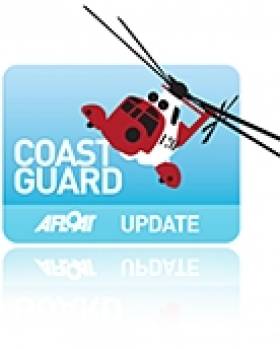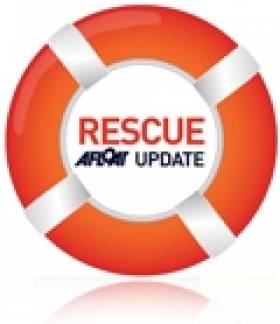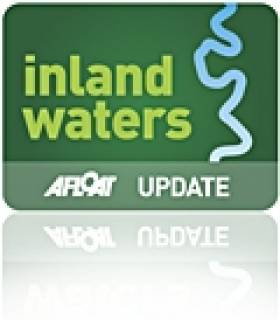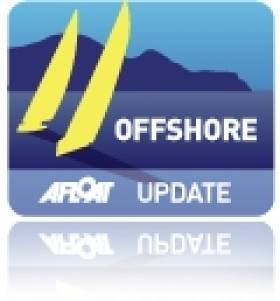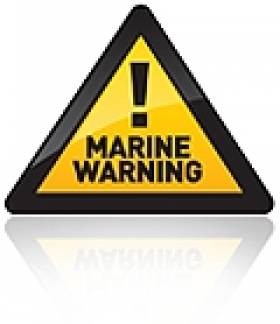Displaying items by tag: Safety
Fishermen Rescued From Sinking Vessel off Ardglass
Belfast Coastguard received a Mayday call at 5:54pm from the Newry registered vessel, which operates out of Ardglass, and immediately sent the Southdown and Portaferry Coastguard Rescue Teams to the scene. The launch was requested of the RNLI Portaferry inshore lifeboat. The Irish Coastguard Rescue Helicopter was tasked but was later stood down.
Steve Carson, Watch Manager, Belfast Maritime Rescue Coordination Centre, said:
"The crew aboard the fishing vessel were rescued by the inshore lifeboat and then taken to Ardglass Harbour where they received medical attention; one of the crew has since been taken to Downpatrick Hospital.
It is imperative to always ensure you are carrying the correct safety equipment and have it serviced regularly. Due to the prompt and appropriate action of the crew I am pleased to say they are all safe but shaken by their traumatic experience.
The rescue was successfully coordinated by Belfast Coastguard with assistance from their colleagues at Dublin, Liverpool and Holyhead Coastguard Stations.
The vessel has now been successfully refloated and is now alongside in Ardglass Harbour."
World Leader in Offshore Simulation Partners with National Maritime College
SEFtec NMCI Offshore Ltd (SNO), a public / private joint venture between SEFtec Global Training Ltd and The National Maritime College of Ireland (NMCI), will be launched tomorrow at the National Maritime College, Co. Cork, by the Minister of Enterprise, Trade & Employment, Batt O'Keeffe.
This venture is a shining example of how to bring together state of the art public infrastructure, in the form of one of the world's most advanced maritime colleges, with private enterprise's expertise in not only offshore training, but in the design, manufacture, installation, commissioning and service of training simulators for the global maritime industry.
The Minister for Enterprise, Trade and Innovation, Batt O'Keeffe TD, who launched the public-private joint venture, said it would support jobs and the growth of the Irish offshore exploration and wind energy sectors. 'The future is bright for the partnership we are announcing here this afternoon. The maritime sector is a diverse and developing global industry that requires huge levels of skill and technical capability,' said Minister O'Keeffe.
Focused on supporting the successful and sustainable growth of the Irish offshore exploration sector, SNO has successfully secured the approval of the Offshore Petroleum Industry Training Organization (OPITO) for its programme of courses. In a sector that is completely focused on safety,OPITO has become the global industries focal point for skills, training and workforce development.
"SNO is very proud to have achieved its OPITO approval this year, the approval came about in a phenomenal time frame and this wouldn't have been possible without the combined efforts of both public and private joint venture partners. This will mean that we can service not only the growing needs of Ireland's offshore sector, but train for the global industry as well" Conor Mowlds, Managing Director SNO Ltd.
SEFtec, an Irish SME with a global focus, commenced trading in 2004 and has quickly become one of the world's leaders in the provision of offshore simulation equipment. Based in a state-of-the-art facility in Cork it has diversified its activities from the design and fabrication of offshore training simulation equipment to training and already operates an OPITO centre in Kazakhstan.
The NMCI, a public private partnership between the Cork Institute of Technology, Vita Lend Lease and the Irish Naval Service was opened in 2004, represents a €60 million investment by the state in maritime training, and is one of the world's most advanced maritime colleges.
The future aim of SNO is to break into the offshore renewable energy sector, with the development of their Offshore Wind Energy Safety Training course (OWEST) ear marked for further development. The OWEST course currently involves Helicopter Winching Techniques, Life Saving Appliances and Vessel Abandonment which is key training for anyone working on or near Offshore Wind Energy Sites.
See below for photos taken this morning at the National Maritime College in Ringaskiddy of delegates on the OPITO approved BOSIET - Offshore Training Course, using the Helicopter Underwater Training Simulator
Safety Precautions for Vessels and Crew
Owners and masters availing of winter mooring facilities for their vessels on any of Waterway Ireland's navigations are advised to choose a sheltered berth within the harbour, place adequate fendering between the vessel and the harbour wall and secure the vessel with double mooring lines.
The vessel should be monitored on a regular basis in the event that it should be taking or making water and particularly so after a period of stormy or frosty weather.
Owners visiting harbours during this period and who intend to work on their vessels should bear in mind the changed environmental conditions at this time of year and to take the appropriate measures necessary to reduce risks associated with working on or near water.
It is advised that personal protective clothing, to guard against the cold and the wet, including a personal flotation device, should be worn and all items checked for serviceability beforehand, bearing in mind:
• Low air temperatures
• Low water temperatures
• Reduced daylight
• Inclement weather
• Raised water levels
• Flood conditions including increased rates of flow
Working on or near water should preferably be undertaken in the company of a colleague. Lone working should be avoided if possible and especially at remote locations. Ensure that someone has been informed of your whereabouts and expected time of return.
Further, carry a mobile phone and/or a handheld Marine VHF, fully charged, for keeping in contact while being aware that full phone coverage is not available everywhere.
Irish Sailors Tell of 'Vicious' Conditions in the Med
Both Irish skippers who retired from the Rolex Middle Sea Race that finishes today at the Royal Malta Yacht Club have described the 'vicious' conditions encountered in the Mediterranean this week. The fleet suffered several knowdowns and at least one man overboard but the bulk of the fleet were safely secured in either Marsamxett Harbour this morning with just two racing. 15 had retired.
Last night Dun Laoghaire's Cathal Drohan, sailing his third Middle Sea Race on the X41 Legally Brunette, spoke of 40 knots squalls and visibility near shipping lanes being reduced to five or six boat lengths.
"The boat was well founded and we had a great crew but after five days racing we were looking at a further long stretch of sailing and a severe forecast". Drohan told Afloat.ie from Malta.
All skippers in the race were mindful of the safety of crews given one sailor had been seriously hurt in a knockdown in a heavy squall.
The Royal Malta Yacht Club has calculated the winners and these are set out below.
Barry Hurley sailing on the Maltese yacht Aziza sent the following back to Afloat.ie after the yacht retired:
"We were sailing in sustained low 30knts all day Tuesday and encountered several vicious squalls, often adding up to 20 knots to the average windspeed. Such squalls are common in the area and always play a significant part in the Middle Sea Race. By Wednesday morning the seas had grown substantially and rounding Pantelleria we received an updated weather forecast for sustained mid 40's on Wednesday afternoon. We believe we were lying 4th overall at that stage so were keen to press on, but faced with the prospect of potential 60's in the squalls we made the decision to retire into Pantelleria in the interest of safety. A few hours later an Italian X Yacht came in alongside needing medivac for a crew member seriously hurt in a knockdown in just such a squall, so our decision was vindicated. A somewhat disappointing end to another fantastic Middle Sea Race, but for now it's back home to Dublin until the Sydney Hobart race in December".
Press Release from organisers:
ROLEX MIDDLE SEA RACE CLASS WINNERS CONFIRMEDOctober 28, 2010
If the early miles of the Rolex Middle Sea Race were a test of patience, the latter miles were a true test of endurance. A strong mistral of up to 40+ knots helped push the fleet homeward to the finish in Malta. The last two yachts, Zizanie and Amethyst Abroad, were around the island of Lampedusa and racing towards the finish line off the Royal Malta Yacht Club. The two boats showed heaps of perseverance for hanging in, even if the northwesterly breeze had subsided to a 'mere' 25+ knots.
Meanwhile the bulk of the fleet were safely secured in either Marsamxett Harbour or around the corner in Grand Harbour Marina, and the overall class standings were sorted as the last boats trickled in.
IRC Overall – Lucky (USA)
IRC 1 – Esimit Europa 2 (SLO)
IRC 2 – Lucky (USA)
IRC 3 – Jaru (MLT)
IRC 4 – Artie (MLT)
ORC Overall – Jaru (MLT)
ORC 1 – E1 (RUS)
ORC 2 – Varuna (GER)
ORC 3 – Jaru (MLT)
ORC 4 – Three Sisters (CZK)
Double Handed – BOV Plain Sailing (MLT)
Racing offshore double handed is not for the faint-hearted. It requires all-round seamanship, determination, stamina and above all courage. At the 606-nautical mile Rolex Middle Sea Race, the Double Handed Class is somewhat under the radar with only three entrants, but this year's competitors were a diverse and experienced group.
Taking line honours in the Double Handed Class was White Star, a custom 54-footer, which finished yesterday afternoon with an elapsed time of 4 days, 6 hours, 44 minutes, and 18 seconds. But the Italian boat would have to wait until today when BOV Plain Sailing finished, to see who would win on corrected time.
White Star's crew were experienced double handed sailors Diego Tisci and Daniele Chiamenti; Tisci is a veteran of eight Rolex Middle Sea Races, Chiamenti several as well, but this is the first double handed Middle Sea for either of them. An Italian owner built the yacht and is entering it in double handed races as a way to showcase its' potential. As Tisci said, "This was the first race of a new program for the boat. It was like a test; so we see how the yacht goes, how we have to optimize that and the crew.
"We had a problem at the start and we broke the jib, this is why we stayed far to the east on the way to Messina. We could only use the staysail and code zero, which doesn't allow you to sail very close to the wind – that's why we had a very strange track! At the end that was the best we could do. Around Stromboli, we didn't have much wind and again it was difficult to go to weather without the proper headsail.
Chiamenti explained, "After that the race was very strategic. But our strategy was based on the sails that we had, not on the wind!" When the forecast coincided with this strategy, White Star was in good shape. From Trapani on, the northwest breeze allowed them a favourable point of sail. To add to their woes, White Star lost instruments as well. The two sailors estimated maximum wind speed at approximately 35 knots; but off the wind, and with a staysail set, they were good to go.
Asked about the best part of sailing double handed, Tisci said with a smile "I think the team.
But really, I like sailing short-handed. It's nice to be at sea. You don't have to argue about what you think is right or wrong; it's your race, just yours. You aren't a wheel in a big mechanism; you are only the mechanism. And we take all decisions together."
The two concurred about the course, and Chiamenti said, "For sure it's the best race in the Mediterranean. It's very tactical, and the panorama is great. You've got a volcano, you've got the Messina Strait, and the time of year is great, it's not too cold, not too warm.
The 34-footer, BOV Plain Sailing, crossed the line midday on Thursday after five days, zero hours and 52 minutes at sea. Their corrected time was good enough to give the Maltese boat the Double Handed Class overall win.
Maltese sailing veteran, skipper/owner Anthony Camilleri is no stranger to the Rolex Middle Sea Race, sailing in his tenth race. But his crew, Gilbert Azzopardi has never raced two-handed before and neither has the boat. The Tango 34 is the smallest and lightest boat of the 76 yachts that started the race.
Camilleri spoke dockside after completing the race, "I am delighted that we have won, but first and foremost, I must give a mention to Bepe Bisotto, skipper of Atame. We had a great battle, often side-by-side, but when we developed a problem with the reefing lines of our mainsail, he offered to stop and help. That offer of assistance shows the spirit of our discipline, we look after each other.
"Probably the lowest moment in the race was the last night. We were tired and the weather was really bad, up to forty knots of wind on the beam, with six metre waves crashing into the cockpit. We took down the mainsail and continued under storm jib alone, it was the hardest part of the race. This race is one of contrasts and the previous day the sailing was spectacular. Downwind with the spinnaker up, we were surfing at a constant 12 knots, at times accelerating to 18 knots. It is an amazing feeling with just the two of us, a very special moment."
Last night, the Fast 42 Atame pulled into Trapani to get a respite from the relentless wind and sea. Beppe Bisotto emailed, " 'Ad impossibilia' (it's impossible), as the Latins say. Ian (Knight) and I shared the same thinking. Outside, a Force 8 gale is blowing hard from the north. No way to pass Favignana island, as we had been stopped for ten hours with no wind. We missed the wind shift, blowing at SW Force 7 straight into the face, with forecast predicting force 8 on the back. More than this, to Pantelleria Force 7 SW on the nose was forecast. So, surrounded by gales, we decided to stop and avoid any possible damage. Do not forget that we were only two- handed instead of a full crew of eight to ten. By the way, we are happy to have raced faster than many bigger boats with full crew! Atame is definitely solid, fast, and reliable."
Only the x40 Pita Maha (ITA), retired today, bringing the total number of retired boats to 15, with 58 boats finished, and two still racing.
Recall for XM Liferaft Batch
Navimo have recalled a batch of XM liferafts due to mini-leaks that could affect the liferafts' performance. The problem is confined to a limited batch of XM liferafts manufactured in the Far East carrying part numbers 53871 to 53876. This batch of rafts was manufactured from early 2006 onwards and were probably sold after June 2006.
‘While we’ve had no reports of any incidents with this batch of rafts, we take this matter extremely seriously,’ said Paul White, Navimo UK sales manager. ‘We just don’t feel comfortable offering a safety product that – no matter how small the possibility - might put anyone at risk.
‘So we want to get that entire batch of rafts back and replace them - free of charge - by the same type of product manufactured in our European factories.’
Navimo says any company with a raft - or rafts - from the affected batch should contact Carl Gilbert-Wood on 01489 778853, or email [email protected] to arrange for shipment back to Navimo.


























